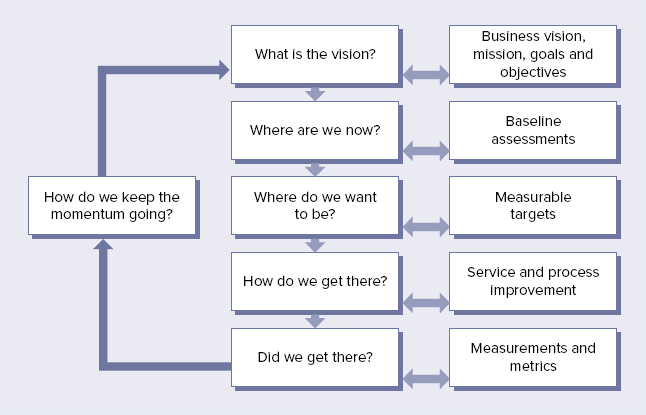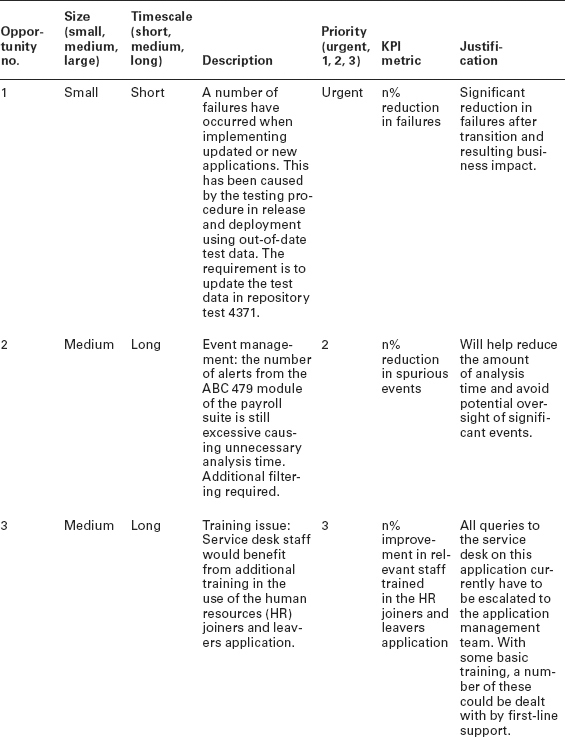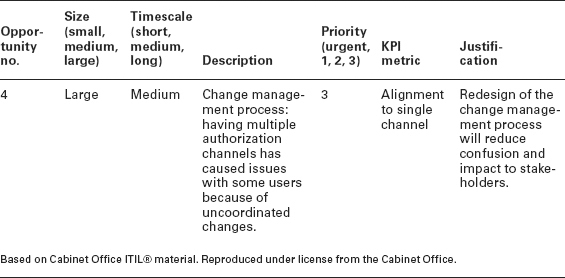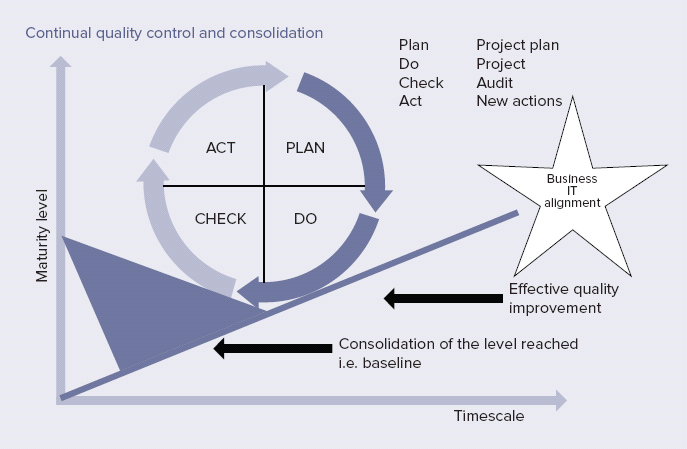Achieving Continual Service Improvement
Continual service improvement is key to the success of the service management approach, because organizations do not stay static in their requirements. Reviewing performance and identifying improvement opportunities allow the continued development of higher-quality, lower-cost services, in line with the objectives of the business.
Understanding the Purpose of CSI
The purpose of continual service improvement (CSI) is to continue to support the business with IT services in the face of changing business needs. Consider for a moment exactly what that may mean in your organization.
In most companies, there are business drivers that cause changes in behavior to meet market forces. Organizations that do not respond to outside forces or recognize the need to change will usually not survive the rigors of the marketplace. The same should be applied to the provider of the IT services that support the business. The idea that an IT service provider will be viewed differently is quite surprising, but this is often the perception in an IT department. Continual service improvement is there to make sure that the changes in business processes that keep the business alive and thriving are recognized and that the IT services that support those processes change with them.
Think about these statements:
- You cannot manage what you cannot control.
- You cannot control what you cannot measure.
- You cannot measure what you cannot define.
Measurement is critical to the success of continual improvement. Without defined measures, it is difficult to manage improvements. CSI is concerned with the improvement of all aspects of the service lifecycle, from strategy through design, transition, and operation. Failure to implement processes that support your services, which are measurable, repeatable, and manageable, will have an impact on the business. It is necessary to engage with your organizational goals and use them to provide clear objectives for your IT services. If defined services and processes do not support business activity, it will become increasingly difficult to keep up with the organization’s need for change. Depending on the criticality of the services, the impact on the business may be loss of productivity, higher costs, damage to reputation, or potential risk of business failure. Mitigating against or preventing such an impact is a key driver for continual service improvement. Applying the continual service improvement process across the service lifecycle will enable continued support for business activities.
In addition to this, continual service improvement should be seeking improvements in cost effectiveness and efficiency. This application of continually searching for enhancement should also be applied across the whole lifecycle, including CSI itself.
The Objectives of CSI
To achieve the purpose for this lifecycle stage, the ITIL Continual Service Improvement publication provides the following objectives:
- Review, analyze, prioritize, and recommend improvement opportunities in each lifecycle stage: service strategy, service design, service transition, and service operation, as well as CSI. Regular activity of this type will move the improvement from an ad hoc approach to a genuine improvement initiative.
- Review and analyze service level achievements, according to the service level agreements in place.
- Identify and implement specific activities to improve IT service quality, including improvements to the effectiveness and efficiency of the enabling processes. The overall service quality is partially dependent on the quality of the processes. It can be tempting for IT services to assume that the only metrics that matter are those relating to the technology.
- Improve the cost effectiveness of IT service delivery, without negatively impacting customer satisfaction. Customer satisfaction is an important measure of the value of the service being delivered.
- Ensure suitable and applicable quality management methods are in use to support the continual improvement activities. The quality management methods in use should support the overall quality governance in place in the organization.
- Ensure that the processes in use have clearly defined objectives and measurements, which produce identifiable and actionable improvements. This should be part of the controls around the processes in use throughout the service lifecycle.
- Understand what to measure, why it is being measured, and what the successful outcome should be. Recognizing exactly what is required will enable a better interpretation of the metrics and the behaviors they will drive.
Setting the Scope for CSI
The ITIL Continual Service Improvement publication provides guidance in four main areas:
- The overall health of IT service management as a discipline
- Continual alignment of the IT services with the current and future needs of the business
- The maturity and capability of the organization, management, processes, and people utilized by the services
- Continual improvement of all aspects of the IT service and the service assets that support them
It is only by understanding how the improvements are to be carried out, and what the desired outcomes are, that you can deliver continual service improvement. The activities that support improvement are as follows:
- Reviewing the service performance targets and trends, using the available management information, to understand if the desired service levels are being met
- Reviewing process outputs to understand if the required performance is being achieved to enable the services
- Regularly carrying out maturity assessments on the processes in use to identify areas of concern or demonstrate improvement achievements
- Conducting compliance audits on the processes, ensuring maturity is maintained
- Identifying and making proposals for improvements
- Conducting customer satisfaction surveys as required on a periodic basis
- Reviewing and understanding business trends and projections, maintaining awareness of business priorities
- Measuring and identifying the value created by continual improvement initiatives
These activities will require ownership to ensure that they actually get done. Improvement activities should be planned and be part of a considered approach, managed by individuals who have appropriate authority to carry them out. It is important to make sure that the processes and services are subject to a continual improvement strategy. This strategy should ensure that the improvement initiatives are achieving their targets and being kept up-to-date. Specific improvements, which require changes, should follow the change management process. It is easy for improvement programs to fade, so it is necessary for these activities to be monitored as part of the overall continual service improvement approach.
How CSI Provides Value to the Business
The adoption of standard and consistent approaches to improving IT service quality will result in controlled, gradual, and maintainable improvement. Any improvements must, naturally, be cost justified in terms of the return on the investment or, more appropriately, on the value of the investment.
By employing regular reviews of the business needs and ensuring that IT services remain aligned to them, the business can be assured of an acceptable level of support. Because IT services may be said to underpin the success of the majority of organizations, this assurance is critical for business confidence.
One of the key aspects of any improvement is cost, but it is not only the cost justification for the initiative; it is also the benefit that can be achieved in terms of cost. An improvement may be able to create cost savings in real terms or increase capability for additional workload. Because one of the most common themes of budget negotiations is the requirement to achieve more for the same or less than the previous year, this is a genuine long-term goal for organizations. Utilizing the techniques and approaches of continual service improvement will allow for a gradual and sustained increase in capability, because the effectiveness and efficiency of the processes and services are managed.
But it is not only the processes and the services they support that are under the scrutiny of continual service improvement. It looks at all elements that enable the delivery of services to the business. This will include all resources, partners, technology, staff skills, training, and communications. The emphasis on a holistic approach to improvement means that true business benefits can be achieved by delivering cost-effective enhancements across the wider enterprise. For example, renegotiating contracts with third-party suppliers may deliver an ongoing benefit to the business.
To achieve these benefits, it is necessary to ensure that monitoring and reporting on performance across the service portfolio allows for the identification of improvement opportunities.
Utilizing the Continual Service Improvement Approach
We will now cover the approach proposed by ITIL for continual service improvement, illustrated in Figure 13.1.
FIGURE 13.1 Continual service improvement
Based on Cabinet Office ITIL material. Reproduced under license from the Cabinet Office.

There are key questions that need to be asked as part of implementing improvements. These are all covered by the continual service improvement approach. The first step is to identify the vision that is driving the improvement initiative. Understanding the high-level focus of the business will allow for the alignment of the IT services and the business strategies.
The question that needs be asked by the IT service provider in this step is “What is the vision?” This enables identification of the ultimate and long-term goals for the improvement.
Once the vision has been established, the next step requires an objective assessment of the current state, namely, a baseline capture of the organization in terms of business, people, process, and technology. Utilizing this information will give a picture of the current service provision and its quality. The question asked at this step is “Where are we now?”
Having established where you are now, the logical next question is “Where do we want to be?” This is not necessarily the achievement of the vision identified at the start of the approach. In fact, it is probably unwise to have that as the answer, because unless it is an easily achievable goal, it is unlikely to be reached. A better approach is to identify an achievable target, one that will enable some quick wins and gain some buy-in for the improvement opportunity. Working in small steps, identifying achievable targets that build steady progression to the overall goal will enable your improvements to be consolidated at each target.
Targets are important, but equally important is the requirement to understand how you achieve them. The next question of “How do we get there?” covers identifying the actions needed to meet the targets. This can take a number of different approaches, depending on the improvement that is required. It could be process improvements, technology improvements, or even training for staff. It is important to ensure that this activity is captured and managed as part of an overall improvement program. The responsibility for monitoring the actions will be critical in achieving the targets, because often improvement initiatives will lose focus and fail at this step. Driving the actions and maintaining momentum will provide the input for the next step of the approach.
That next step is measuring the achievements, and the question that is applied is “Did we get there?” When working on service performance improvements, this is documented as part of the service reviews and performance metrics against the required service levels. Measuring the actual performance delivery and comparing this to the predicted target will provide the answer to “Did we get there?” Specific targets in process improvement may be measured in terms of a maturity matrix, for the efficiency and effectiveness of the process. This is the point in the CSI approach where you understand whether you have achieved the goals when asking “Where do we want to be?” This keeps the momentum of your improvements going, potentially providing quick wins.
You then need to review your overall objective and begin the cycle of assessment, target setting, and measurement again.
This approach can be adopted at all stages of the service lifecycle, from improvements in service strategy to improvements in your approach to continual service improvement itself.
Capturing Your Improvements
Using the CSI approach, you will no doubt end up with more than one improvement initiative running at once. It is therefore necessary to manage your improvement activity, so you need to have a mechanism for capturing these programs and ensuring that you allocate your resources and capabilities efficiently.
The recommendation for best practices is to develop a CSI register; Table 13.1 shows an example, where all the individual improvements can be recorded. This means you can apply some categorization and management around the overall CSI approach.
TABLE 13.1 Example of a CSI register


As you can see in the example register, the first level of categorization is to establish the size of the undertaking or task. The suggested approach is to simply use a broad categorization such as small, medium, or large. This will indicate the requirements for resources and capabilities for the initiative.
In addition, you need to establish the timescale for the improvement—can it be achieved in the short, medium, or long term? A brief description of the initiative will provide suitable context for the audience. Also important is to understand the urgency of the improvement, and as always within the framework, urgency and impact based on the business perspective will identify the priority of the action. The register should also provide some indication as to the measures or metrics that will be applied to verify a successful outcome from the improvement. The prediction of achievement is an important factor in determining success, because this will be compared to the actual achievement for the final evaluation.
A brief outline of the justification for the improvement should also be captured as part of the register, but the full details of the initiative will be captured as part of the improvement program documentation. In the example given, there is no contact information or reference to timeframes for completion. Contact information for who raised the improvement and who will be working on it and, of course, the date by which it is required will be necessary. In this example, there are only a limited selection of possible fields; the register should contain whatever information you need, according to the requirements of your own organization, for managing your improvement programs. The register itself will be classed as a service asset and as such should be managed as an item in the service knowledge management system (SKMS). The CSI manager will be accountable for managing and coordinating the activities.
Capturing the information about the improvements will provide structure and visibility for CSI within the organization. It will be necessary to ensure that the interfaces for all processes likely to generate improvement activities are clearly understood and their outputs effectively managed through the register, such as problem management, capacity management, and change management. This should include service review outputs, because this is a common source for finding requirements for improvements.
Improving Quality with the Deming Cycle
One of the many approaches available in improvement activities is the use of the Deming cycle. W. Edwards Deming is best known for his management philosophy, leading to higher-quality, increased productivity and a more competitive position for the organization. By utilizing the elements of his approach that are applicable for service management, you have the Plan-Do-Check-Act steps that make up the Deming cycle, illustrated in Figure 13.2.
FIGURE 13.2 Plan-Do-Check-Act cycle: Continual quality control and consolidation
Based on Cabinet Office ITIL® material. Reproduced under license from the Cabinet Office.

The cycle is now commonly referred to as the PDCA cycle, and we will briefly cover each step.
In the Plan stage, you are doing exactly that, planning the activity for the improvement. Ensuring that there is a plan is part of all service management activity, and it is also part of the governance controls within standards such as ISO/IEC 20000 (the Service Management standard). The PDCA cycle is complementary to the CSI approach and the seven-step improvement process. We will cover the seven-step process later in this chapter.
In the remaining stages of the PDCA cycle, you carry out the activity as defined and agreed on in the plan. In the Do step of the process, it is important to capture the activity and make updates to the CSI register. Following this comes the Check step, which consists of checking on the activity that has been carried out. In terms of ongoing improvement, this step and the following step, Act, are used to monitor, measure, review, and implement initiatives. At the conclusion of the cycle, there is a consolidation effort, which, as you can see in Figure 13.2, prevents the circle from rolling back down the slope. The effort of reaching a target may be considerable, but often the effort required to maintain the achievement is just as great. The PDCA cycle allows you to manage this effectively.
The cycle is underpinned by a process-led approach to its management. This means that defined processes are in place, the activities are measured for compliance to agreed-upon values, and the outputs are audited to identify improvements.
The Role of Measurement in CSI
Measurement is a fundamental part of all processes; in fact, it is one of the key characteristics of a process, because all processes must be measurable. CSI cannot take place without the results of measurement, so a key part of this lifecycle stage is to identify the nature of the measures you want to employ and ensure that these are appropriate to identify the improvements that will benefit the organization as a whole.
To be useful, measures must be objective. The role of measurement is to provide the following:
- An assessment of the current status
- The identification of improvement areas
- A measurement of enhancements made
Because your organization’s business processes depend on the delivery of services, you must also consider the measures that will be applied to services. Most organizations will measure the following:
- Availability of the service
- Reliability of the service
- Performance of the service
Critical Success Factors and Key Performance Indicators
ITIL describes a critical success factor (CSF) as something that must happen if an IT service, process, plan, process, or other activity is to succeed. Key performance indicators (KPIs) are used to measure the achievement of each critical success factor.
The CSI manager will be instrumental in assisting the process owners and managers to understand the CSFs for each process and to develop appropriate KPIs to measure their success.
Establishing and measuring the CSF for a process will enable an understanding of the current state of the process, help identify any required improvements, and measure the achievement of any enhancements made.
It is recommended that a service or process have no more than two to five associated CSFs at any one time and that each CSF have no more than two to five KPIs for measuring success. This way, you can be sure of having manageable measurement and meaningful results.
In the early stages of maturity for the process or service, it is probably best to limit the numbers of KPIs still further and measure only two or three. You can add more as the maturity of the service and the service management processes increases, but initially it is important to define the most appropriate measures as a starting point. Over time, the requirements for measurement will change, as the maturity of associated processes increases or new processes are included in the service management scope.
KPIs can be either quantitative or qualitative. It is necessary to identify the specific metrics and measurements required to calculate the desired KPI. The following sidebars show you some examples for both types of KPI.
- Original customer satisfaction score for handling incidents
- Ending satisfaction score for handling incidents
- Incident handling survey score
- Number of survey scores
- Original cost of handling printer incidents
- Final cost of handling printer incidents
- Cost of the improvement effort
- Time spent on the incident by first-level operative and their average salary
- Time spent on the incident by second-level operative and their average salary
- Time spent on problem management activities by second-level operative and their average salary
- Time spent on the training first-level operative on the workaround
- Cost of a service call to third-party vendor
- Time and material from third-party vendor
Another important aspect that you should consider is whether a KPI is fit for use. There are a number of questions you should ask to determine this. Does the performance indicator tell you anything about the goal achievement? If you do not meet the target set for the performance indicator, does that mean you will not achieve your goal? Or if you do achieve the performance target, will you achieve your goal? Performance indicators should be relevant and provide useful information. They should also be easy to interpret and be manageable. By this we mean that it should be easy to change the performance indicator to meet changing requirements, and it should also be proof against external influences. Consideration should be given to the frequency of data capture and the availability required for the output. What conditions will the performance indicator work under, and when will it be impacted sufficiently so that it will no longer work? And lastly, who owns the performance indicator, and who is responsible for collecting and analyzing the data?
KPIs are very important in the overall approach to CSI, and it is important to remember that whatever measures you put in place, they will potentially drive behavior, so you should be careful to ensure that the behavior you create is desirable. A suite of measures is always preferable so that you do not focus on only one particular behavior.
Using Different Types of Metrics
In general, a metric is a scale of measure that allows you to define what is to be measured. It is usually associated with a standard or specific unit of measurement. Metrics are used in a number of different business models including CMMI, COBIT, and Six Sigma and typically are used to track performance in the form of KPIs.
There are three types of metrics that an organization will need to collect to support the activities of CSI and other service management processes:
Using Baselines in CSI
Baselines can be used to provide a clear starting point for any improvement activity, so it is important that when you capture a baseline, you are assured that it’s accurate.
Taking a snapshot of the infrastructure, services, and processes at a given point in time is valuable, but in order to use this as a basis for later comparison or as a starting point, the snapshot should be verified against the actual environment before it is declared as an official baseline.
Capturing regular baselines will improve the ability of service management to forecast performance requirements. Ensuring that baselines are documented, recognized, and accepted through the organization is part of the responsibility of CSI. It is important to establish baselines at all levels, including for strategic goals and objectives, tactical process maturity, and operational metrics and KPIs.
When you first start to capture data, it may be inaccurate or lacking in integrity, but it should form the very first baseline, because it is better to have some data rather than none at all. Improvements can be made in the data capture and in the integrity so that future baselines will reflect the improvement that has been made.
